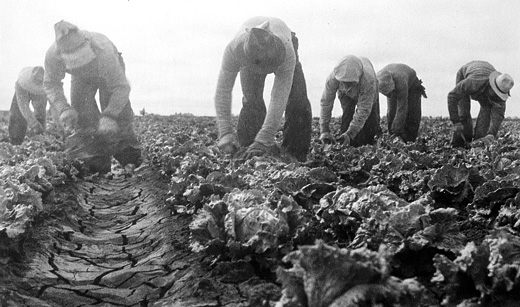
On August 27, 1934, Filipino lettuce cutters and mainly white packing shed workers struck the powerful Salinas Valley, California, growers and shippers, demanding union recognition and improved working conditions. But the growers used divisive tactics and scab labor to cause setbacks to the workers’ struggles.
White workers who were refugees from the depression and the dustbowl came to Salinas for work in its thriving lettuce fields. Workers were housed in roadside camps with poor sanitation.
After World War I, California growers began importing farmworkers from the Philippines, which the U.S. had taken control of after a war with Spain in 1898.
Laws were passed forbidding Filipino women from entering the U.S. In many rural towns it was a crime for Filipino men to associate with non-Filipino women. The growers hoped to keep their expenses down by employing a work force of single men, with disastrous social consequences. But in the early 1930s, the Filipino workers responded by organizing into associations that led some powerful strikes.
Collective bargaining rights for most hourly workers in the United States were first given legal protection in 1933 by Section 7a of the National Industrial Recovery Act (NIRA). Although NIRA did not specifically exempt agricultural laborers from the protection of the Act, the Roosevelt administration, eager to win the political support of farm-state members of Congress, argued that farm workers were excluded.
When the National Labor Relations Act (NLRA) was enacted in 1935, it specifically exempted agricultural workers due to pressure from the “farm bloc” in Congress. Although a number of attempts were made in the 1920s, 1930s, and 1940s to organize farm laborers, these efforts were unsuccessful.
In 1934, when the Filipino lettuce cutters and mainly white packing shed workers struck demanding union recognition and improved conditions, they made an agreement between them, neither group would bargain without the other.
After several weeks of an effective strike, the grower-shippers agreed to bargain. The agreement was made on a Saturday night. “Send your workers back to work immediately,” said the bosses, “and we’ll negotiate on Monday.” Sunday is not a workday and no one returned to work until Monday.
When Monday came the growers sat and negotiated with the packing shed representatives, but they refused to even talk with Filipino representatives because they had “violated the agreement to return to work immediately.”
While the packers union was negotiating its contract, organized vigilante gangs were burning down Filipino labor camps, driving Filipino organizers from the valley and bringing in scabs to break the field strike.
For more information, read 1934-36 Salinas Strikes – Divide and Conquer on the website http://www.farmworkers.org/strugcal.html, an initiative of Sin Fronteras Organizing Project.
To this day, farmworkers struggle for better wages and working conditions, and fight the lengths the growers will go to suppress worker unity.
Filipino American labor marks 45th anniversary of grape strike
The farm workers’ Filipino-American champion
What I learned from the Immokalee workers
Photo: Filipinos cutting lettuce. Salinas, California, June 1935. Repository: Library of Congress Prints and Photographs Division Washington, DC 20540, http://hdl.loc.gov/loc.pnp/pp.print

MOST POPULAR TODAY


Zionist organizations leading campaign to stop ceasefire resolutions in D.C. area

Communist Karol Cariola elected president of Chile’s legislature

Afghanistan’s socialist years: The promising future killed off by U.S. imperialism

High Court essentially bans demonstrations, freedom of assembly in Deep South






Comments